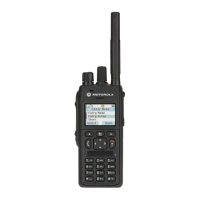2 If Phone or PABX is not the first type of call presented, press Ctype repeatedly to select it.
3 Press the Send key.
4 To end the call, press the End key.
5.6.2.2
Using the Phone/PABX Speed Dial
Procedure:
1 From the home screen, enter the predefined Phone/PABX speed dial number and # key.
2 Press Send key.
5.6.3
Receiving Individual Calls
Procedure:
1 Use one of the following methods to answer a private, phone, or Private Automatic Branch
Exchange (PABX) call.
• Press the PTT button.
• Press the Send key.
2 To end the call, press the End key.
5.7
MS-ISDN
This feature adds to your radio ISDN number. You can choose between MS-ISDN and ISSI to address
the call, send the message or pre-defined templates. It works for both simplex and duplex calls, based
on the assigned ISDN number.
5.8
One-Touch Dial
This feature allows you to call by pressing and holding one of the keys (1-9).
NOTICE: If the One-Touch Button feature is disabled, One-Touch Dial is disabled as a
consequence. If no feature is assigned to a button that you press, your radio displays an
Unassigned Button message.
In RMS mode, the One-Touch Button feature is disabled.
5.9
Radio Messaging System (RMS)
NOTICE: This is a Software Selling Feature.
The Radio Messaging System (RMS) feature allows the radio to receive and send RMS messages
through the TETRA network using the Short Data Service (SDS-TL) or Status (STS) as the transport
layer.
NOTICE: One-Touch Buttons are disabled in the RMS mode.
There are two types of RMS messages:
68015000797-EH
Chapter 5: Features
124

